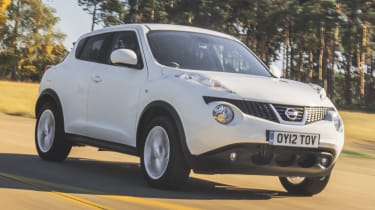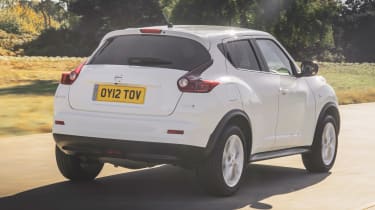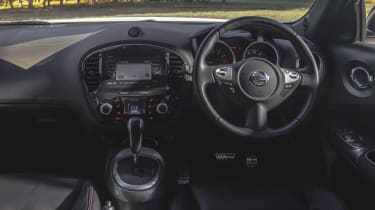Nissan Juke (Mk1, 2010-2019) icon review: a divisive trailblazer
Love it or hate it, the Nissan Juke was a game-changer when it first arrived in the UK
We’re already bracing ourselves for an Inbox onslaught. The Nissan Juke? An icon? No, we haven’t completely lost our senses. An automotive icon does not have to be universally loved; it can be divisive, and even, as is the case here, something of a hate object for many car enthusiasts. The most important thing is its significance in the car world, and for the Juke, that can’t be overstated.
Arriving a few years after Nissan’s genre-defining Qashqai, the smaller Juke injected further interest into higher-riding cars, but in a cheaper, more compact package. By using the ‘B’ platform shared with the likes of the Micra and Note, the firm could carry over a range of tried and tested small engines, plus keep the weight down, and the price low.
Today, almost every supermini has a lifted, small SUV equivalent built on the same architecture and sharing an identical set of engines. But back then, this was a revolutionary idea, and one that was clearly worth pursuing, with the Juke clocking up 136,000 European deliveries in its first year on sale. Nissan’s competitors took note, and imitators soon followed.
The Juke’s popularity came despite its Marmite looks. These shouldn’t have come as a surprise when the car was revealed at the Geneva Motor Show in 2010; the Qazana concept that previewed it at the Swiss event the previous year was as mad as a box of frogs. Inevitably, it had to be toned down, but not by much. It still tapered in the middle in the old-fashioned ‘Coke bottle’ style with cartoonish wheelarch bulges at either end, and it kept the weird split-light design with 370Z-like upper sections that housed the indicators and daytime running lights, rather than the headlights.
More reviews
Car group tests
In-depth reviews
Long-term tests
Road tests
- New Nissan Juke 2024 facelift review: welcome changes inside, but dull to drive
- New Nissan Juke Hybrid 2022 review
Used car tests
It was inevitable that not everyone would be fond of the looks. The Juke has been a staple of ‘ugliest cars’ articles ever since, if not appearing quite as frequently as the likes of the Pontiac Aztec and the SsangYong Rodius. It certainly stood out at the time, but nearly a decade and a half on, there are so many of these about that they now blend into the background.
And so, when approaching the 2012 example lent to us from Nissan UK’s heritage fleet, there are no feelings of shock or revulsion, merely cool indifference; it’s just such a familiar sight. Things get more interesting on the inside, though. The difference in quality between this and the first-generation Qashqai is clear – it feels much more premium inside the Juke, and the design has more flair.
The elliptical interior door handles are a nice touch, while splashes of glossy plastic trim do a good job of lifting the cabin ambience. The centre console was said to be inspired by a motorcycle’s fuel tank, and it could be customised with various different colours. The steering wheel looks remarkably similar to the part used in the 370Z, adding a sense of sportiness to proceedings. The level of equipment is good, too, this being a range-topping Tekna model. Heated seats, cruise control and climate control are among the highlights. The latter feature works out of a neat-looking digital screen towards the bottom of the central stack, and wouldn’t look out of place in something much more modern. Further up is a small infotainment system with a colour touchscreen and sat-nav. Despite its age, the system is actually pretty useable.
The vast majority of Jukes sold in the UK were front-wheel drive, but this is one of the rare 4x4 examples. Unfortunately, opting for four-wheel drive meant being lumbered with a continuously variable transmission (CVT). Front-driven Jukes all used either five or six-speed manual gearboxes.
CVTs have improved in recent years, but in 2012 they weren’t brilliant. As such, there’s that usual feeling of disconnect between throttle inputs and how the car responds, with the engine speed proving erratic when you put your foot down. You can live with it, though, and the 1.6-litre ‘DIG-T’ turbocharged four-cylinder petrol engine is reasonably refined. It’s powerful, too, offering 187bhp. Were this a manual Juke, it could hit 0-62mph in less than eight seconds, but the CVT increases the sprint time to 8.4 seconds.
The steering has a good weight to it, and is surprisingly direct off-centre. This does encourage you to be a little enthusiastic with cornering speeds, only to find the limits of the Juke’s reasonably soft suspension. There’s a reasonable degree of body roll, although we’re not talking about comedic value levels of lean. Despite the Nissan being fairly softly sprung, the ride is merely fine, and can be a touch jiggly over some surfaces.
Get it up to cruising speed and hold it there, and the Juke seems like it would be a perfectly adequate car for covering large distances, with a good degree of refinement. You’ll just need to pack light, because the boot space stands at just 251 litres. Dropping the rear seats doesn’t help much either, because this expands the load space to a still-disappointing 550 litres.
It’s cramped in the back for passengers, too, so other than gaining a little more headroom, you do have to question what you’re getting with the Nissan over a supermini. And although the second-generation Juke addressed the original’s practicality issues to some extent (while also tidying up the aesthetics a touch), this is a debate that still rages for this segment.
Buyers clearly don’t care, though. Demand for B-SUVs shows no sign of slowing. A monster has been unleashed, and quite improbably, it’s all down to one of the quirkiest-looking cars to come out in the past 20 years.
What we said then
- Issue 1,118, 9 June 2010
Given the stand-out styling, high fun factor, trio of advanced engines and prices starting at only £12,795, the Juke represents excellent value for money. And based on this first encounter, there is nothing to suggest it won’t emulate the Qashqai’s success.
Interested in buying one?
The Juke is the newest car we’ve looked at in this series so far. As such, supply is plentiful, and you shouldn’t need to worry too much about issues relating to rust or reliability. That is so long as you stick with a manual car, because there are reports of the CVT misbehaving. It’s expensive to put right when it goes wrong.
With there being so much choice, it’s worth avoiding the base-spec Visia trim level, which doesn’t come with much in the way of equipment, and opting for the mid-grade Acenta or the range-topping Tekna. N-Tec was later added to slot between those two trims.
If your budget allows, you might want to opt for the 2014-on facelifted model, which came with improved equipment and tweaked looks. There’s also the sportier Nismo and the later Nismo RS to consider, but neither of these is particularly thrilling to drive.
| Model: | Nissan Juke Mk1 |
| Production dates: | 2010-2019 |
| Price then: | From £12,795 |
| Price now: | From £3,000 |
| Engine: | 1.6-litre 4cyl turbo petrol |
| Power/torque: | 178bhp/240Nm |
| Transmission: | Six-speed manual, front-wheel drive |
| 0-62mph: | 8.4 seconds |
| Top speed: | 124mph |







